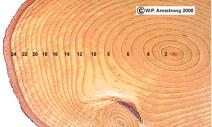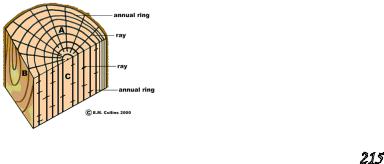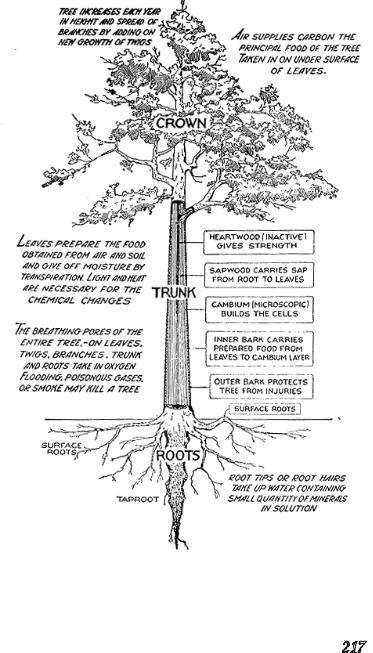
Учебник по НТП
.pdf
three large blocks - two areas of northern (boreal) forest (in Canada, Alaska, and Russia), and one relatively contiguous area of tropical forest spanning the northwestern Amazon Basin and Guyana Shield (in Brazil, Peru, Venezuela, and Colombia). Additional important outliers can still be found in Central Africa (Congo), and Papua New Guinea. However, nearly 40 per cent of these remaining frontier forests face a moderate to high threat of degradation or clearance.
Vast forests are essential to life itself. They absorb carbon dioxide (the main climate-altering gas in the atmosphere) and produce oxygen, anchor soils and prevent erosion, regulate water flow and protect watersheds, modify climate and cool the air, and provide a habitat for millions of species of plants and animals. By providing water cycle regulation, soil conservation, and biodiversity, forests are vital to maintaining healthy ecosystems - on which humanity depends.
Forests also provide more direct benefits to the world’s economies, including wood-based commodities such as timber, fuelwood, and pulp for paper and packaging. They provide foods, medicines, spices, gums, resins, and oils. Forest products are used for everything from lumber for housing and furniture to books and myriad other paper products. Even in the Internet age the flow of information still depends on paper.
Forest products, mainly timber, pulp and paper, and fuelwood, are worth about $400 billion to the global economy. Non-wood forest products, such as fruits, vegetables and medicines, provide up to $20 billion a year and are growing rapidly in importance.
More than a decade of discussions on how to protect the world’s forests has resulted in substantial changes in the way forests are managed. Policies and programs to help promote sustainable forest management have been devised and have taken hold in many countries. Nevertheless, deforestation is continuing at a rapid rate, particularly in the tropical forests of Africa and South America.
Forest loss is caused by a complex set of social and economic pressures. Among the major factors contributing to deforestation and forest degradation are conversion of forests to farmland and poor forest management, including over-logging, forest fires, and increased harvesting of wood fuels and other forest products for household use.
The key to the saving the forests is in policy changes and adapting current practices. It is possible to gain sustainable timber yield through efficient forest management. Practices must be looked at from long term forest management instead of from the short term perspective many unfortunately have been using for years.
It is not about ending all cutting of trees. It is how, where and when trees are cut down. Clear cutting is when all the trees are cut for acres and acres. This is extremely destructive to the forest environment and its fragile eco-system. Changing to a system of managed forestation,
213

loggers go into the forest and pick and choose which trees to cut, based on age and location. Much more labor intensive, but this is the way it has to be done in order to be managed properly. The use of lumber and resources for the trees can still be enjoyed by people, yet the preservation of forests can be maintained. Seems like a small price to pay.
Wood structure
The microscopic cellular structure of wood, including annual rings and rays, produces the characteristic grain patterns in different species of trees. The grain pattern is also determined by the plane in which the logs are cut at the saw mill. In transverse or cross sections, the annual rings appear like concentric bands, with rays extending outward like the spokes of a wheel.
This basswood (Tilia americana) trunk cross section has 24 distinct annual rings. The central core of wood counts as the first year of growth since the pith is no longer present. The smaller series of concentric rings (knot) at the bottom of the photo is a lateral branch embedded in the main trunk.
In a tree trunk, all the tissue inside the cambium layer to the center of the tree is xylem or wood. All the tissue outside the cambium layer (including the phloem and cork layers) is the bark. Some botanists prefer to use the term phellem for the corky bark layer because it develops from a special meristematic layer outside the phloem called the phellogen. The wood of a tree trunk is mostly dead xylem tissue. The darker, central region is called heartwood. The cells is this region no longer conduct water. They appear darker because they often contain resins, gums and tannins. The lighter, younger region of wood closer to the cambium is called sapwood. Although they are dead, the cells in this region serve as minute pipelines to conduct water and minerals from the soil. Xylem cells are alive when they are initially produced by the meristematic cambium, but when they actually become functioning water-conducting cells (tracheids and vessels), they lose their cell contents and become hollow, microscopic tubes with lignified walls.
An article in Science Vol. 291 (26 January 2001) by N.M. Holbrook, M.
214

Zwieniecki and P. Melcher suggests that xylem cells may be more than inert tubes. They appear to be a very sophisticated system for regulating and conducting water to specific areas of the plant that need water the most. This preferential water conduction involves the direction and redirection of water molecules through openings (pores) in adjacent cell walls called pits. The pits are lined with a pit membrane composed of cellulose and pectins. According to the researchers, this control of water movement may involve pectin hydrogels which serve to glue adjacent cell walls together. One of the properties of polysaccharide hydrogels is to swell or shrink due to imbibition. «When pectins swell, pores in the membranes are squeezed, slowing water flow to a trickle. But when pectins shrink, the pores can open wide, and water flushes across the xylem membrane toward thirsty leaves above.» This remarkable control of water movement may allow the plant respond to drought conditions.
Wood is cut longitudinally in two different planes: tangential and radial. Tangential sections are made perpendicular to the rays and tangential to the annual rings and face of the log. This plane is also called slabcut or plane-sawed lumber. The annual rings appear in irregular, wavy patterns. This is the plane in which most lumber is cut at the saw mill. In the manufacture of plywood, thin sheets of veneer are peeled off of a rotating tree trunk. The sheets of veneer are glued together with the grains of each sheet at right angles to each other. An odd number of sheets produces 3-ply and 5-ply boards. The alternation of sheets greatly increases the strength and durability of plywood lumber. With modern glues, particles and chips of wood are also cemented together to form strong particleboards. Different grades of particleboard contain different sized wood chips. Fiberboard differs from particleboard in that wood fibers, not chips of wood, are used.
Radial sections are made along the rays or radius of the log, at right angles to the annual rings. This plane is also called quarter-sawed lumber because the logs are actually cut into quarters. The rings appear like closely-spaced, parallel bands. The rays appear like scattered blotches. Because the dense, dark summer bands (annual rings) are closely spaced, this plane is also more wear-resistant.
Three planes of wood:
A. Transverse
B. Tangential
C. Radial
215
Knots are the bases of lateral branches (limbs) that have become completely enveloped by the growth of new xylem tissue produced by the cambium layer of the trunk. Knotty pine boards from lodgepole pine (Pinus contorta) and other species make attractive wall paneling and cabinetry.
The thick, outer layer of bark on a tree trunk is composed of suberized cork cells which contain a waxy, waterproof coating called suberin. The thick cork layer or phellem is produced by a special meristematic layer (outside of the cambium and phloem layers) called the phellogen. The cork layer becomes deeply fissured as the trunk expands in girth. Special openings in the bark layer called lenticels allow for gas exchange. Lenticels are very prominent in some stems. In Portugal, the thick cork layer is peeled off of the cork oaks (Quercus suber). The phloem layer is not destroyed, and the cork can be harvested repeatedly from the trees. In most trees, peeling off the bark will kill the tree because the vital phloem layer is also ripped away and destroyed. Removing a ring of bark from the trunk of a tree or shrub is called girdling. Cork is still the best stopper for perishable beverages, such as fine wines, because other synthetic polymers may affect the flavor and quality of the wine. For obvious reasons, bottle corks are generally cut at right angles to the lenticels.
VI. Enhancing Skills in Russian-English Interpretation
Render orally the following text:
Строение Дерева
Дерево, как известно, состоит из кроны, ствола и корней. Крона дерева - это ветви и листья или хвоя. Преобразуя углекислый
газ и воду в сложные органические вещества, листья передают их всему дереву для роста и жизни. Использование кроны в промышленности невелико. Из листьев (хвои) получают различное лекарственное сырье, ценную витаминную муку для животноводства и птицеводства, из ветвей производят технологическую щепу для изготовления тарного картона, древесноволокнистых плит и т. п.
Ствол проводит влагу с растворенными минеральными и органическими веществами от корней к кроне и обратно. Он дает основную массу древесины (от 50 до 90 % объема всего дерева). Древесина ствола имеет большое значение и применяется в разных отраслях народного хозяйства. Тонкую часть ствола называют вершиной; нижнюю, толстую часть - комлем.
Корни служат для получения из почвы питательных веществ и удерживают дерево. Используют корни как второстепенное топливо. Пни и крупные корни хвойных пород (особенно сосны) после валки
216

217

деревьев служат сырьем для получения скипидара и канифоли.
Cтроение и свойства древесины
Существует три основных разреза ствола:
Поперечный разрез проходит перпендикулярно оси ствола и образует торцевую плоскость.
Радиальный разрез - продольный, проходит через сердцевину ствола. Тангентальный разрез проходит вдоль ствола, но удален от
сердцевины на разное расстояние.
Рис. 1. Основные разрезы ствола:
1 - поперечный (торцевой); 2 - радиальный; 3 - тангентальный.
На поперечном разрезе ствола различают: кору, древесину с годичными кольцами и сердцевину (рис. 2).
Рис. 2. Поперечный разрез ствола и строение древесины:
1 - сердцевина; 2 - сердцевинные лучи; 3 - ядро; 4 - заболонь; 5 - годичные кольца; 6 - камбий; 7 - лубяной слой; 8 - кора
Кора покрывает дерево сплошным кольцом и состоит из наружного слоя (пробкового) и внутреннего (луба). Пробковый слой защищает дерево от влияний внешней среды и механических повреждений; луб - служит проводником сокодвижения.
218

Кора бывает самой разной по виду и цвету. Она используется для дубления кож, получения некоторых химических веществ, служит сырьем для производства лекарственных препаратов, а также дегтя; из пробкового слоя изготавливают поплавки, пробки, теплоизоляционные и строительные плиты. Из луба делают мочало, рогожи, веревки и многое другое.
Камбий - тонкий слой живых клеток, располагается между корой и древесиной. В камбии ежегодно на протяжении периода роста дерева происходит образование новых клеток, вследствие чего древесина увеличивается на толщину годичного слоя - кольца.
Древесина с годичными кольцами составляет основу ствола и имеет главное промышленное значение. Она располагается концентрическими годичными кольцами от центральной узкой части ствола в виде рыхлой ткани - сердцевины до периферийной - коры.
Уотдельных пород центральная часть древесины имеет более темную окраску. Эта часть ствола называется ядром, а более светлая, периферическая - заболонью. Такие породы древесины называют ядровыми. К ним относятся: дуб, ясень, сосна, лиственница и др. Породы,
укоторых нет явного различия между периферической и центральной частью ствола, называются безъядровыми. Безъядровые породы, в свою очередь, подразделяются на спелодревесные и заболонные.
Успелодревесных пород глубокие слои отличаются по цвету от молодых, но имеют одинаковые свойства и строение. К таким породам относятся липа, ель, пихта и другие.
Узаболонных пород по всей толще строение древесины одинаковое. Восходящее сокодвижение у таких деревьев происходит по всей толщине ствола. Примером служат береза, осина, ольха, клен.
Сердцевинные лучи имеются в любой древесной породе. У одних они слабо заметны, у других ярко выявлены и имеют различную окраску. Они хорошо просматриваются на поперечном разрезе
светлыми блестящими линиями, направленными от сердцевины к коре. Служат они для проведения воды, воздуха и питательных веществ в горизонтальном направлении. Сердцевинные лучи создают красивый рисунок и дополняют декоративные качества текстуры древесины.
Q:How can you tell if a tree is a dogwood tree?
A:By its bark!
Q:What kind of tree fits in your hand?
A:A palm tree!
219
VII. Solving Translation Problems
A prefix is a syllable or word affixed to the beginning of a word in order to change its meaning. Notice that premeans comes before and fix means attach. Thus a prefix is something attached before the word.
Copy out the underlined words and define what their prefixes mean. Explain the meaning of the word or the whole phrase or sentence.
Examples:
It is atypical. (prefix a- means away, away from, from, or not) Meaning: It is not typical.
He used the binoculars to see the distant figures. (prefix bi- means two) Meaning: He used the optical device for two eyes to see the distant figures.
Charcoal
Charcoal is the blackish residue consisting of impure carbon obtained by removing water and other volatile constituents of animal and vegetable substances. It is usually produced by heating wood in the absence of oxygen, but sugar charcoal, bone charcoal (which contains a great amount of calcium phosphate), and others can be produced as well. The light, black, porous material is 85% to 98% carbon, the remainder consisting of volatile chemicals and ash, and resembles
coal.
The first part of the word is of obscure origin. The independent use of «char», meaning to scorch, to reduce to carbon, is comparatively recent and must be a back-formation from the earlier charcoal. It may be a use of the word charren, meaning to turn, i.e., wood changed or turned to coal; or it may be from the French charbon. A person who manufactured charcoal was formerly known as a collier, though the term was used later for those who dealt in coal, and the ships that transported it.
Production of wood charcoal in districts where there is an abundance of wood dates back to a very remote period, and generally consists of piling billets of wood on their ends so as to form a conical pile, openings being left at the bottom to admit air, with a central shaft to serve as a flue. The whole pile is covered with turf or moistened clay. The firing is begun at the bottom of the flue, and gradually spreads outwards and upwards. The success of the operation depends upon the rate of the combustion. Under average conditions, 100 parts of wood yield about 60 parts by volume, or 25 parts by weight, of charcoal; small scale production on the spot often yields only about 50%, large scale was efficient to about 90% even by the 17th century. The operation is so delicate that it was
220

generally left to professional charcoal burners. These often worked in solitary groups in the woods and had a rather bad social reputation, especially travelling ones who often sold a sack (priced at about a day’s wage) with lots of rubbish mixed in to farmers and townfolk.
Historically the massive production of charcoal (at its height employing hundreds of thousands, mainly in Alpine and neighbouring forests) has been a major cause of deforestation, especially in Central Europe. The increasing scarcity of easily harvested wood was a major factor for the switch to the fossil-fuel equivalents, mainly coal and brown coal for industrial use.
The modern process of carbonizing wood either in small pieces or as sawdust in cast iron retorts is extensively practiced where wood is scarce, and also by reason of the recovery of valuable byproducts (wood spirit, pyroligneous acid, wood tar), which the process permits. The question of the temperature of the carbonization is important; according to J. Percy, wood becomes brown at 220°C., a deep brown-black after some time at 280°, and an easily powdered mass at 310°. Charcoal made at 300° is brown, soft and friable, and readily inflames at 380°; made at higher temperatures it is hard and brittle, and does not fire until heated to about 700°.
One of the most important historical applications of wood charcoal is as a constituent of gunpowder. It is also used in metallurgical operations as a reducing agent, but its application has been diminished by the introduction of coke, anthracite smalls, etc. A limited quantity is made up into the form of drawing crayons; but the greatest amount is used as a fuel, which burns hotter and cleaner than wood. Charcoal is often used by blacksmiths, for cooking, and for other industrial applications. Commercially, charcoal is often found in either lump or briquette forms. Lump charcoal is made directly from hardwood material and burns hotter than briquettes. While some briquettes are made from a combination of charcoal, ash, binders (lime, clay, starch), and possibly additives like paraffin or lighter fluid to aid in lighting them, other “natural” briquettes are made solely from charcoal and a starch binder.
Nine of every ten tons of coal used in the United States are used for electricity generation.
Here’s how it works: coal is burned to heat water into steam in an electric power plant, then the steam turns a turbine that drives a generator that produces electricity. During this process, about 2/3 of the energy in the coal is used up to make electricity, or becomes waste heat, and only 1/3 winds up being delivered to users as electricity.
221
The porosity of wood accounts for its ability to readily absorb gases and liquids; charcoal is often used to filter water or absorb odors. Its pharmacological action depends on the same property; it absorbs the gases of the stomach and intestines, and also liquids and solids (hence charcoal filters are used in some types of gas mask to remove poisonous gases from inhaled air).
Animal charcoal or bone black is the carbonaceous residue obtained by the dry distillation of bones; it contains only about 10% carbon, the remainder being calcium and magnesium phosphates (80%) and other inorganic material originally present in the bones. It is generally manufactured from the residues obtained in the glue and gelatin industries. Its decolorizing power was applied in 1812 by Derosne to the clarification of the syrup obtained in sugar refining; but its use in this direction has now greatly diminished, owing to the introduction of more active and easily managed reagents. The decolorizing power is not permanent, becoming lost after using for some time; it may be revived, however, by washing and reheating.
Charcoal is used in art for drawing, making rough sketches in painting, and is one of the possible media for making a parsemage. It must usually be preserved by the application of a fixative. Artists generally utilize charcoal in three forms:
Vine charcoal is created by burning sticks of wood (usually willowor linden/Tilia) into soft, medium, and hard consistencies. Bamboo charcoal is the principal tool in Japanese Sumi-e art.
Compressed charcoal is charcoal powder mixed with gum binder compressed into round or square sticks. The amount of binder determines the hardness of the stick. Compressed charcoal is used in charcoal pencils.
Finely powdered charcoal is often used to “tone” or cover large sections of a drawing surface. Drawing over the toned areas will darken it further, but the artist can also lighten (or completely erase) within the toned area to create lighter tones.
One additional use of charcoal rediscovered recently is in horticulture. Although American gardeners have been using charcoal for a short while. Research in the Amazon has found widespread use there by natives to turn otherwise unproductive soil into very rich soil.
VIII. Mastering English Grammar
Translate the sentences into Russian paying special attention to the equivalent-lacking grammatical structures:
1. The CONSOL Corporation’s Blacksville Number 2 mine in Kuhntown, Pennsylvania, was started in the 1970’s and since very early in its operational life has had effects in 2 states - Pennsylvania and West Virginia, where the exit for the mined coal is.
222
